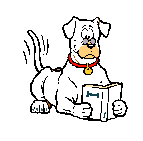 |
Canine Learning Center, Inc. |
| Why Do You Need Puppy Class? |
 |
Canine Learning Center, Inc. |
| Why Do You Need Puppy Class? |
Why
Do You Need Puppy Class?
Make
it Easy, Start Them Young
by Leah Spitzer
(As
published in the August 2000 edition of the IACP newsletter:
The
Safehands Professionals)
I see them every new session. The 9 month old Labrador retriever who drags his owner into the class. The 10 month old shepherd who lunges on the leash and barks. The sheltie who hides behind mom and refuses to walk.
The first night of a beginnerís obedience class usually brings a least one of each; but it also brings my puppy graduates. The puppy graduates are barely noticeable the first night. Why? Because they arenít pulling, hiding or barking. They are social with the other dogs, with the people and they are having a good time.
Private behavioral counseling brings out even more frustration for both the owner and the trainer. I know I find these the hardest. Most of the behavioral problems I work with could have been avoided if the owners had brought the dog to puppy class. Aggression, shyness and even some separation anxiety could have been avoided in puppy class under a trained eye.
My puppy classes focus on an introduction to the world: to the HUMAN world. We teach the puppies our rules, our culture, and our lifestyle. Puppies learn to be brave, to be focused and calm when asked, and of course, to learn the rules.
But even more important , as a trainer, I am on the lookout for warning signs. Iím looking for dominance, for shyness, for touch sensitivity and for over-bonding. I am showing the owners the way to start out RIGHT. I am helping to keep the mistakes from happening. It is so much easier to work with a clean slate.
Many owners do not know they are in trouble until the dog becomes a liability. The untrained eye will miss the warning signs. The slightly pushy or mouthy pup can turn into a biter. The sweet, quiet sheltie can become a recluse with separation anxiety. Owners can inadvertently teach dogs the wrong lessons.
A good puppy class should be the most important part of a puppyís life. Socializing at an early age is important. Being observed by a trained eye is even more important. Puppy classes should teach the puppy:
∑ that learning is fun
∑ that the owner is fun
∑ that the owner is in charge
∑ that other dogs are fun
∑ to control of his mouth, both for biting and for chewing
∑ confidence, but not to the point of being overbearing
∑ leash manners
∑ to come when called
Catch it early and itís easy. Miss it, and itís tough. Sometimes, itís irreversible. Recently, I met with a woman with a lab mix. Deep down inside, Daisy is a sweet dog. Daisy is now two years old and biting her childrenís friends. Our discussion today was a tough one. It was about options. How reliable will Daisy be? Will she ever be trustworthy? Is euthanasia in the forecast?
What makes this case particularly tough for me is that I feel strongly that if Daisy had come to puppy classes, this could have been avoided. Daisy is a fearful dog. Quick movements frighten her. Strangers frighten her. The owners say the problem began about 6 months ago. Thatís when the first bite occurred. However, under a trained puppy instructor, itís possible the problem would have been identified at 4 months of age and corrected. Now? Well, now we are exploring options.
If I had but one wish with regard to dog training, it would be that all pet owners bring their puppies to class as early as possible. It is no longer necessary to wait til the puppy is 6 months of age to come to school. A good puppy class will be designed for the young pup. It will be designed for his attention span, for his learning capacity, and for his physical abilities. And a good puppy class will get him off to the right start.
I rarely see dogs in behavior consultations that went to a good quality puppy school between 3 and 5 months of age.
”
Reprint only with permission of author